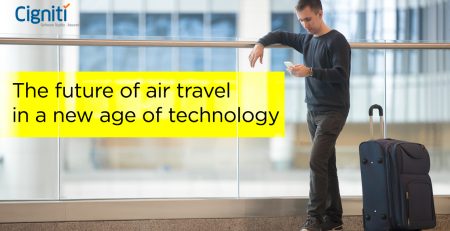Customer Experience Evolution – The Air Travel Story
It is a very well-known fact that if we have to identify sectors that are the most volatile and sensitive to even a small trigger in the social, economic, or political environment, the list will not be complete without the airline industry.
Recessions, pandemics, regulations, and the like have hit the airlines like no other, and the industry is turning around slowly and gradually after a big, unprecedented shock.
Today, for an airline company’s CEO, one of the most important questions in his/her mind is whether to go asset lean or retain the fleet, whereas for a planning specialist, the challenge is to decide on which routes to resume operations after the COVID forced an unexpected closure.
And if you are an airline technology enthusiast, you would be breaking your head thinking about which use cases are going to be value-adding, if not disruptive, that will give them a competitive edge in this time of returning to the skies.
All these decisions have multiple dimensions to them, but a common overarching element is the customer experience, and customer experience is one of the most complex but crucial puzzles to solve for airlines.
In this blog, we shall walk through the evolution of customer experience in the airline industry over the decades, but before we get into the discussion of the history and evolution of customer experience, it is important for us to know the key decision points that constitute a typical travel experience, say a leisure trip, and how that is shaped through the various stages of travel.
- Where to travel or the location (space)
- When to travel and or the time of travel
- How to travel or the mode of travel, and
- How much to spend on travel?
Most leisure travelers fix a budget and then pivot around other factors before finalizing an itinerary, and thanks to a large extent to technology, today’s traveler can make a factual decision after evaluating a number of options available at his/her fingertips. But the travelers in our previous generations a few decades ago were in a different world altogether.
Believe it or not, air travel five to six decades ago was an extra luxury. It was like someone today preparing for space travel on SpaceX or Virgin Galactic, where only the super elite had the disposable income to afford travel over the land and across the ocean. Not only that, the whole process of travel, right from weighing the flight schedules, through booking, to travelling, was cumbersome.
Let’s analyze some of the stark contrasts in customer experience between a 20th century traveler and today’s.
Customer Experience – Now and Then
Making a reservation
In the 1900s, and until de-regulation kicked in, travelers had very limited options to choose from while planning for their air travel. By the 1950’s, the demand for air travel grew considerably, putting pressure on airlines’ reservation processes. A typical traveler on that day will visit a ticketing agent or phone in to make a reservation. The whole ticket booking process was manual, and a single ticket booking took an average of about 90 minutes to complete. Fast forward to today, one can complete an itinerary booking in less than 5 minutes and the whole process involves no manual intervention in booking a seat.
The in-flight experience
The 1950s and 1960s have become known as the “Golden Age” of flying for really good reasons. In those days, the inflight experience was all luxury, with cocktail bars and even beds on some long-distance flights. There weren’t many classes of reservation until the late 1950’s, and the passengers enjoyed multi-course meals throughout their flights. The travelers enjoyed incomparable seat legroom with wider aisles and reclining seats. In short, the on-board experience was nothing comparable to what we experience today.
Figure 1: Air travel in the 60’s Vs Today. Source- Business Insider
But then there is the other side of the story; one had to have a heavy wallet to afford travel and had to be prepared for a long vacation indeed. A flight those days from east of the United States to the west costed in equivalence of more than 4000 dollars today. And a flight that was completed today with a duration of 20 hours took days and even weeks in the 40’s and 50’s. The Kangaroo Route from Sydney to London, for instance, which Qantas introduced in 1947, took four days to complete, and included stops in Darwin, Singapore, Calcutta, Karachi, Cairo, and Tripoli – and two overnight stays. Today it takes less than 24 hours.
So, what transformations have happened over these many decades in the air travel experience as far as the traveler is concerned? Let’s summarize.
- Thanks to deregulation, airlines got the freedom to set and publish their own fares. It also meant the barrier to entry for newcomers was much lower, leading to more business and operating models. This also resulted in air travel being affordable to a larger mass, which was also a necessity for players to expand their market reach and share.
- Not to mention, de-regulation also led to cutthroat competition. From just one or two classes, such as first class or executive, airlines started segmenting and pricing the seats to appeal to a more heterogeneous customer base. The result was less leg room and less baggage allowance, to name a few for an average traveler.
- One of the most crucial transformations was the airlines’ endeavor to automate the process of booking and ticketing as the increasing demand for air travel strained the ticketing staff. Though a number of initiatives in leveraging computers to automate booking started way back in the 40’s, it was not until 1964, when IBM and American Airlines launched Sabre, that a truly efficient way of managing inventory and booking came to fruition. It was efficient back then!!
- Then there is the airport transit experience. With hub and spoke, low-cost point-to-point and hybrid models in practice today, air travel has flourished outside major airports into 2-tier and 3-tier cities. This means managing travelers’ journeys through airport transit also has gained importance these days.
Visualizing the airline customer journey
From the time when air travel was a luxury and only for the rich, but where the travelers had limited options to choose from, not to mention the length of the process of making a booking; here we are where a large percentage of the working class today use air travel for fast commutes over long distances. What it means is that the profile of a typical travelling customer has changed drastically over these decades, where the working-class customer is the king who demands better service and overall experience. There are more reasons to be focused on customer experience today than ever.
Gartner defines customer experience as “a customer’s cumulative or one-off perceptions and feelings caused as a result of interaction with a company or organization, its products or offerings, and its people and systems.”
There are two important “E’s” that I consider very important to customer experience
- Empowered- This includes the avenues or options that are available for customer to choose from, and the set of tools that will help choose the best as per one’s desires, budget, and preferences
- Engaged – How seamless and engaged the customer is throughout his/ her association with a product or service, in this case; the pre-travel, in-travel and post-travel experience
Let’s do a traveling customer journey map to understand customer experience and the various touch points. A journey map is an important tool used today for designing customer experience.
Cigniti focus on customer experience transformation
A detailed analysis of airline customer experience and touchpoints provides an opportunity to innovate on solutions that enhance the experience in terms of searching, shopping, decision making, booking, and in-flight experience.
Cigniti has a team of specialists who focus on designing solutions around customer experience in multiple industries, including travel, airlines, and hospitality. Its domain center of excellence (CoE) focuses on deeply analyzing industry trends, changing customer behaviors, and the industry’s response in terms of designing and validating solutions around personalized customer preferences.
Need help? Contact our Airlines and Customer Experience experts to learn more about the evolution of the customer experience in Airlines industry.







Leave a Reply